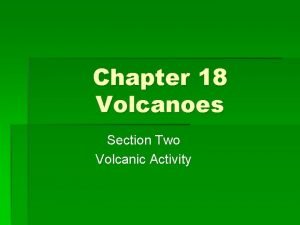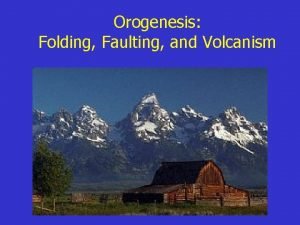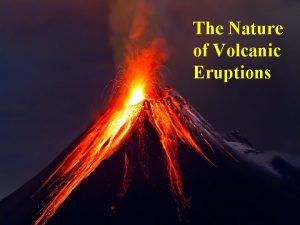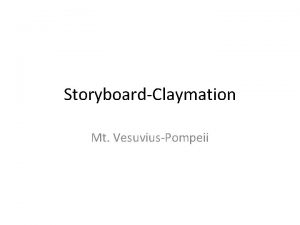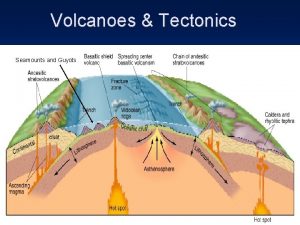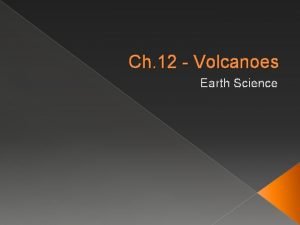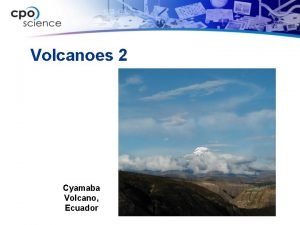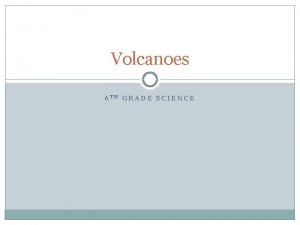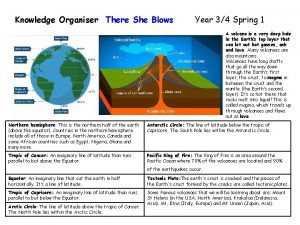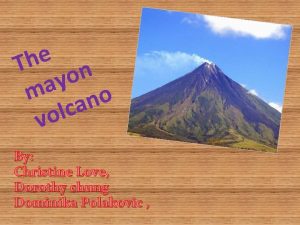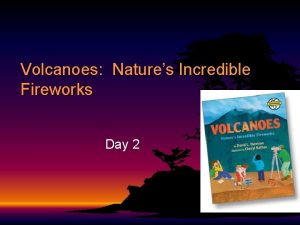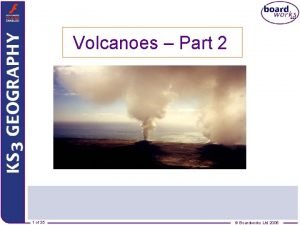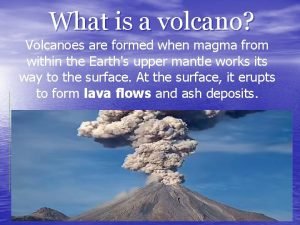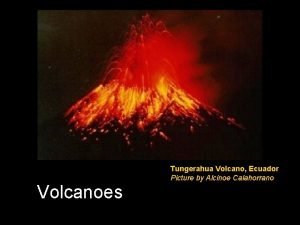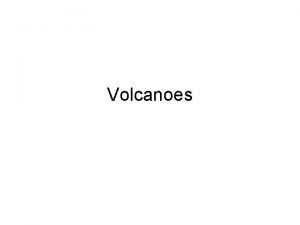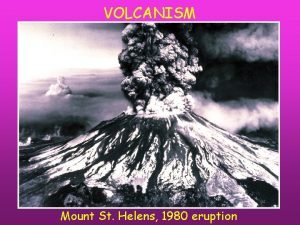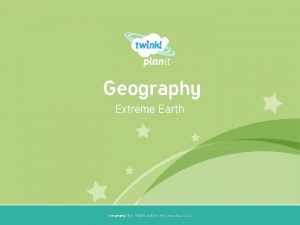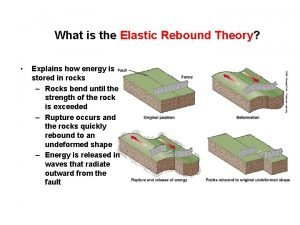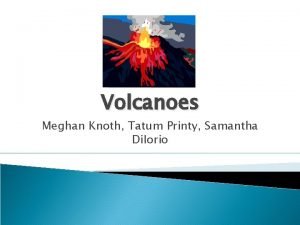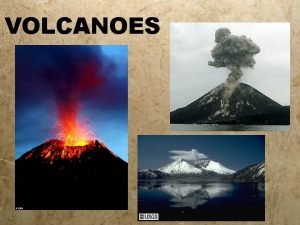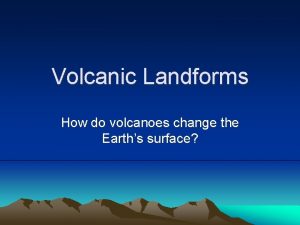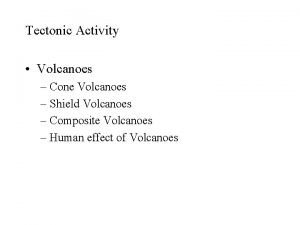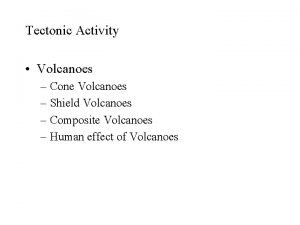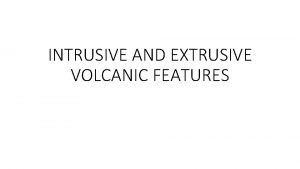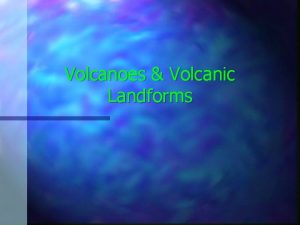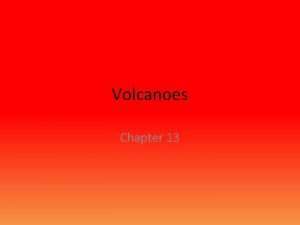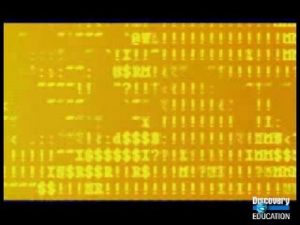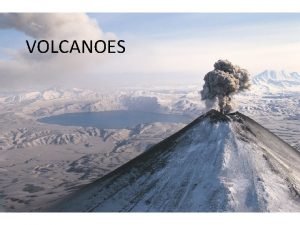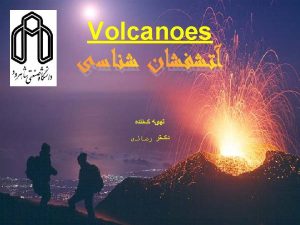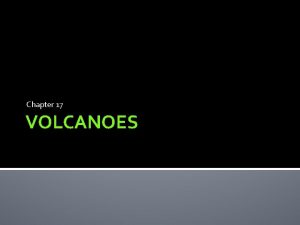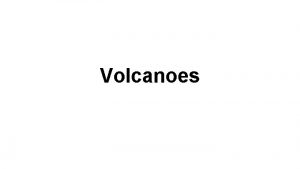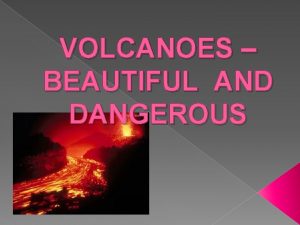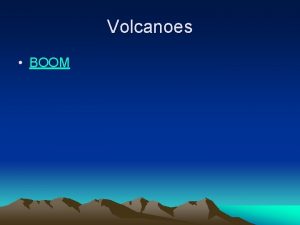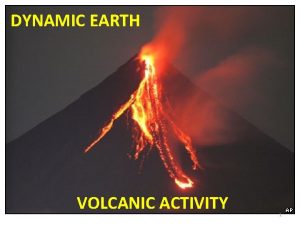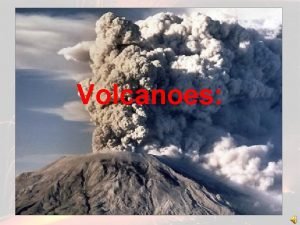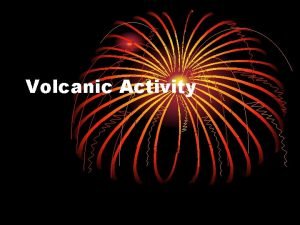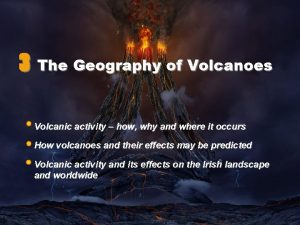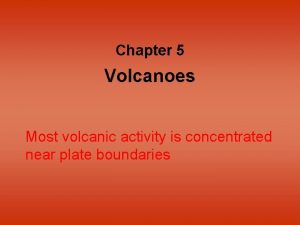Volcanoes A What is Volcanic Activity 1 An























- Slides: 23

Volcanoes

A. What is Volcanic Activity? 1. An opening in Earth’s crust through which molten rock, ash and gases erupt. 2. The landform that develops around the opening. 3. A way for Earth to release heat energy from the interior due to radioactive decay. 4. Energy is provide by Earth’s interior D. Peebles

B. Types of Volcanoes 1. Composite 2. Shield G. Vaughn USGS Mt. St. Helens, WA Mauna Loa, HW 3. Cinder A. Heisey Sunset Crater, AZ

D. Composition • Magma forms when solid rock in the crust and the upper mantle melts • Magma composition plays a major part in determining the formation of the volcano. • Magma viscosity: fluid thickness – Silica content: more = thicker (most explosive) – Temperature: higher= thinner Kilauea, HW D. Peebles, USGS Mt. St. Helens, WA • Mafic – Little silica • Felsic – Lots of silica • Pyroclastic- explosive eruption of particles that are a mixture of gases, ash, cinders (pebble sized lava particles), & bombs (large lava particles) D. Weintraub

E. Types of Lava Flow 1. Flow types: depend on temperature – Pahoehoe: fast moving, hot lava, low viscosity – Aa: slow moving, cooler, high viscosity Aa Flow J. D. Griggs, USGS Pahoehoe Flow J. D. Griggs, USGS D. Peebles, USGS J. Judd, USGS

Destruction • Factors that affect how violent a volcanic eruption are include: – Magma’s composition – Magma’s temperature – Magma’s concentration of dissolved gasses

C. How Do Volcanoes Differ? 1. Size 2. Shape 3. Composition 4. Location

F. Shield Volcanoes 1. Mafic lava (fluid) – nonexplosive eruptions, slow build up – Form over hot spots 2. Structure – Low angle slope – Form islands Tarbuck & Lutgens

G. Cinder Cones 1. Felsic lavas – Large amount pyroclastics – Gentle & explosive – High viscosity 2. Structure – High slope A. Heisey 3. Deep crater Tarbuck & Lutgens

H. Composite Volcanoes • Felsic lavas – Large amount pyroclastics – Viscous lavas – Explosive / catastrophic eruptions – Subduction boundaries • Structure – Symmetrical cone – Medium to high slope • Ring of Fire • Video of types of volcanoes M. Giannechini Pomerape & Parinacota, Chile

Cascade Range • 50+ eruptions in U. S. in past 200 years (mainly in Alaska) • Pyroclastic Flows • Lahars: hot or cold mixture of water and rock fragments flowing down the slopes of a volcano and (or) river valleys Pre 1980 Eruption USGS Post 1980 Eruption

Mt. Saint Helens

May 18, 1980



I. Volcanoes Locations 1. Located along subductive plate boundaries 2. “Ring of Fire”- major volcanic belt, formed around the Pacific Ocean.

3. Hot spots-stationary plume of magma continually rising through the crust from the athenosphere. Can occur in the middle of a plate.


I. Calderas Long Valley, CA 1. Huge hole left by the collapse of the mouth of a volcano. Crater Lake, OR USGS G. Lewis Mauna Loa, HW

J. Other Volcanic Structures 1. Plateaus- flat area caused by lava flow. 2. Volcanic necksmagma left in vent, extinct volcano 3. Dikes- molten material that vertically cut across rock layers 4. Sill- molten material that horizontally cut across rock layers Tarbuck & Luntgens

5. Batholiths- large rock structure that often form the core of mountain ranges, magma cools inside crust 6. Active- erupting or will erupt soon. 7. Dormant- erupt in the future. 8. Extinct- unlikely to erupt again

Volcano Drawing Draw a detailed sketch of each type (pg. 218 Red textbook) - composite, cinder, shield Label all of the parts Color magma/lava red & cinder brown

Checking Your Volcano Knowledge 1. What purpose do volcanoes serve on Earth? 2. What is magma? 3. What does Pahoehoe and Aa refer to? 4. What are three types of volcanoes? Describe each one. 5. What type of materials make up pyroclastic flows? 6. Generally, where are volcanoes located on Earth? 7. How does a caldera form? 8. Which type of volcano is the most explosive?
 Chapter 18 volcanic activity
Chapter 18 volcanic activity What is folding faulting and volcanic activity
What is folding faulting and volcanic activity Chapter 18 volcanic activity
Chapter 18 volcanic activity Paricutin materials extruded
Paricutin materials extruded Volcanoes of italy map
Volcanoes of italy map Three main ways volcanoes are created
Three main ways volcanoes are created Ring of fire volcanoes
Ring of fire volcanoes How are volcanoes formed
How are volcanoes formed N
N Name volcanoes
Name volcanoes Volcanoes knowledge organiser
Volcanoes knowledge organiser Differentiate active and inactive volcanoes
Differentiate active and inactive volcanoes Volcanoes nature's incredible fireworks
Volcanoes nature's incredible fireworks Types of volcanoes according to shape
Types of volcanoes according to shape Crust volcano
Crust volcano Active volcanoes map
Active volcanoes map Volcanic belts form along _____.
Volcanic belts form along _____. Where are volcanoes
Where are volcanoes Extreme earth
Extreme earth The elastic rebound theory
The elastic rebound theory Explain the theory of plate tectonics.
Explain the theory of plate tectonics. Lava and magma difference
Lava and magma difference How are volcanoes classified
How are volcanoes classified Krakatoa volcano
Krakatoa volcano
